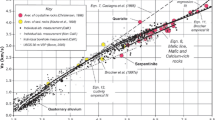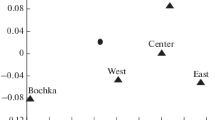Summary
An efficient tool in seismic signal analysis is offered by the array data processing techniques which are based upon similarity of pulse shapes between stations. Records at the six Swedish stations in general exhibit the signal resemblance required by the array methods. By applying a simple processing technique, the signal-to-noise ratio is increased by a factor of about 2, and the accuracy ofP-wave readings is improved. High similarity is found not only between the same phase (P, pP) at different stations, but also between different phases (P, pP) at the same or different stations. Altogether, records of eleven earthquakes were investigated in detail. The Swedish station network can be considered as a ‘super-large aperture seismic array’ (SLASA), despite some differences in instrumental equipment. A general adaptation of array techniques to SLASA systems is discussed. Such methods will greatly improve the seismological information which can be extracted from ordinary station records, provided the stations are located on geologically homogeneous ground.
Similar content being viewed by others
References
T. Asada andK. Takano,Attenuation of short period P waves in the mantle, J. Physics of the Earth11 (1963), 25.
A. Ben-Menahem, S. W. Smith andT.-L. Teng,A procedure for source studies from spectrums of long-period seismic body waves, Bull. Seism. Soc. Am.55 (1965), 203.
R. B. Blackman andJ. W. Tukey,The Measurement of Power Spectra (Dover 1959), 180 pp. Vol. 63, 1966/I)
L. M. Brekhovskikh,Waves in Layered Media (Academic Press 1960), 561 pp.
M. Båth,An investigation of the Uppsala microseisms, Thesis (Uppsala 1949), 168 pp.
M. Båth,Regional centers in seismology, IUGG Chronicle52 (1964), 6.
E. W. Carpentef,Teleseismic methods for the detection, identification and location of underground explosions, VESIAC Rep. 4410-67-X (1964), 1–69, Inst. of Sci. and Tech., Univ. of Michigan, Ann Arbor, Michigan.
J. F. Claerbout,Detection of P waves from weak sources at great distances, Geophysics29 (1964), 197.
W. C. Dean,Coherency, VESIAC Rep. 4410-32-X (1964), 78–82, Inst. of Sci. and Tech., Univ. of Michigan, Ann Arbor, Michigan.
D. Denham,The use of geophone groups to improve the signal-to-noise ratio of the first arrival in refraction shooting, Geophys. Prosp.11 (1963), 389.
E. A. Flinn,Cenfidence regions and error determinations for seismic event location, Rev. Geophys.3 (1965), 157.
B. V. Hamon andE. J. Hannan,Estimating relations between time series, J. Geophys. Res.68 (1963), 6033.
W. J. Hannon,An application of the Haskell-Thomson matrix method to the synthesis of the surface motion due to dilatational waves, Bull. Seism. Soc. Am.54 (1964), 2067.
E. S. Husebye,Correction analysis of Jeffreys-Bullen travel time tables, Bull. Seism. Soc. Am.55 (1965), 1023.
E. J. Kelly,Studies of teleseisms using the Weston Network, Semiannual Technical Summary ESD-TDR-64-346, June 30, 1964 1–5, Lincoln Laboratory, Mass. Inst. of Tech., Lexington, Mass.
E. J. Kelly,Limited network processing of seismic signals, Group Rep. 1964-44, ESD-TDR-64-369, Sep. 4, 1964, 23 pp., Lincoln Laboratory, Mass. Inst. of Tech., Lexington, Mass.
Y. Kishimoto,Investigation on the origin mechanism of earthquakes by the Fourier analysis of seismic body waves (1), Bull. Disaster Prevent. Res. Inst., Kyoto Univ.67 (1964), 1.
M. S. Longuet-Higgins,Some simple visual properties of a Gaussian noise record and their relation to the power spectrum, VESIAC Rep. 4410-32-X (1964), 34–44, Inst. of Sci. and Tech., Univ. of Michigan, Ann Arbor, Michigan.
K. McCamy andR. P. Meyer,A correlation method of apparent velocity measurement, J. Geophys. Res.69, (1964), 691.
O. Nuttli,Some effects of the crust and free surface on the amplitudes of P and S waves, VESIAC Rep. 4410-75-X (1964), 5–18, Inst. of Sci. and Tech., Univ. of Michigan, Ann Arbor, Michigan.
E. A. Robinson,Statistical Communication and Detection with special reference to Digital Data Processing of Radar and Seismic Signals (Griffin & Co., London) (in press).
E. A. Robinson,Mathematical development of discrete filters for the detection of nuclear explosions, J. Geophys. Res.68 (1963), 5559.
Y. Rocard,Azimuthal sensitivity variations of seismograph sites in France, VESIAC Rep. 4410-75-X (1964), 75–80, Inst. of Sci. and Tech., Univ. of Michigan, Ann Arbor, Michigan.
A. Ryall,Improvement of array seismic recordings by digital processing, Bull. Seism. Soc. Am.54 (1964), 277.
T. A. Santô,Energy sources of microseisms in Sweden, Ann. Geofis.15 (1962), 335.
E. F. Sawarenski andD. P. Kirnos,Elemente der Seismologie und Seismometrie, Akademie-Verlag, (Berlin 1960), 512 pp.
J. C. Savage,The stopping phase on seismograms, Bull. Seism. Soc. Am.55 (1965), 47.
M. A. Sellevoll,A publications summary on crustal and uppev mantle structure in Fennoscandia, Iceland and the Norwegian Sed, VESIAC Rep. 4410-75-X (1964), 111–124, Inst. of Sci. and Tech., Univ. of Michigan, Ann Arbor, Michigan.
S. M. Simpson,Time series techniques applied to underground nuclear detection and further digitized seismic data, Sci. Rep. 2, Contract AF 19(604)7378, Dec. 30, 1961. Mass. Inst. of Tech., Cambridge, Mass.
S. M. Simpson,Continued numerical studies of underground nuclear detection and further digitized data, Sci. Rep. 3, Contract AF 19(604)7378, June 30, 1962, Mass. Inst. of Tech., Cambridge, Mass.
R. Stefánsson,Methods of focal mechanism studies with application to two Atlantic earthquakes, Tectonophysics (1966), in press.
S. Suyehiro,Deep earthquakes in the Fiji region—on the nature of deep earthquakes, Papers in Met. and Geophys.13 (1962), 216.
E. Vesanen,Über die typenanalytische Auswertung der Seismogramme, Ann. Acad. Fennica [A]11 (1942), 244 pp.
F. E. Whiteway,The recording and analysis of seismic body waves using linear cross arrays, J. Inst. of Electr. and Radio Eng.29 (1965), 33.
Author information
Authors and Affiliations
Rights and permissions
About this article
Cite this article
Husebye, E.S., Jansson, B. Application of array data processing techniques to the swedish seismograph stations. PAGEOPH 63, 82–104 (1966). https://doi.org/10.1007/BF00875160
Received:
Issue Date:
DOI: https://doi.org/10.1007/BF00875160




